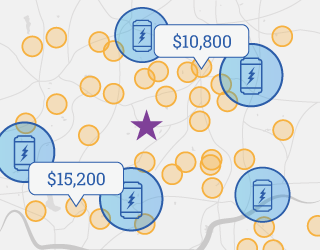Lithium-ion batteries are the most popular products used for solar electricity storage today. Within the umbrella category of lithium-ion batteries, there are several specific chemistries that battery manufacturers employ in their products. These chemistries each have their own advantages and disadvantages, as well as ideal use cases.
Important terms to know related to lithium-ion battery chemistry
In order to understand the main differences between lithium-ion battery chemistries, there are two key terms to keep in mind:
Energy density
A battery’s energy density is closely related to its total capacity – it is a measure of the amount of electricity in Watt-hours (Wh) contained in a battery relative to its weight in kilograms (kg).
Power
In contrast, power is a measure of a battery’s ability to output electrical current. Power is rated in kilowatts (kW), and determines how many appliances can run on a single battery system.
Here’s a quick example: batteries for cell phones will typically have high energy density and relatively low power. This is because using a phone doesn’t take a significant amount of power at any given time, but there is a need to pack as much storage capacity as possible into a slim phone battery. Often times, low power comes with higher energy density, and the reverse applies as well.
Types of lithium-ion battery chemistries
There are several types of lithium-ion batteries both available and in development. We’ve outlined some common chemistries below, including their benefits, drawbacks, and how they stack up relative to one another:
Lithium Nickel Manganese Cobalt Oxide (NMC)
Perhaps the most commonly seen lithium-ion chemistry today is Lithium Nickel Manganese Cobalt Oxide, or NMC for short. NMC chemistry can be found in some of the top battery storage products on the market, including the LG Chem Resu and the Tesla Powerwall.
NMC batteries have a relatively high energy density and an average power rating when compared to other lithium-ion battery chemistries. Additionally, the presence of cobalt makes NMC batteries very safe and reduces the risk of thermal runaway. Importantly, all batteries made for home storage setups and electric vehicles are very safe, but lithium-ion batteries with cobalt included in the chemistry makeup have an added layer of safety to consider.
One further reason why NMC batteries are the predominant chemistry for residential energy storage solutions is their cost: compared to other chemistries, production costs for NMC batteries are on the lower end of the lithium-ion cost spectrum.
What is thermal runaway?
Thermal runaway is the term for an uncontrollable thermal reaction that can occur in batteries under certain conditions. Importantly, all solar batteries approved for residential, commercial, and utility-scale installations have to pass rigorous testing standards to ensure that thermal runaway won’t ever occur. Additionally, factors such as battery pack arrangement, cell casing, and internal cooling all reduce the already very low risk of a thermal runaway reaction starting.
Lithium Iron Phosphate (LFP)
Another battery chemistry used by multiple solar battery manufacturers is Lithium Iron Phosphate, or LFP. Both sonnen and SimpliPhi employ this chemistry in their products. Compared to the other lithium-ion technologies, LFP batteries tend to have a high power rating and a relatively low energy density rating. The addition of iron in LFP batteries improves safety and reduces heat output, meaning that LFP batteries often don’t require the same level of ventilation or cooling as NMC batteries to operate (if any at all). As such, LFP batteries can be installed in more unique locations, including inside your actual property.
Additionally, LFP chemistry batteries tend to have longer lifespans than most other lithium-ion batteries.
Lithium Nickel Cobalt Aluminum Oxide (NCA)
NCA batteries are a newer option on the market. Their main differentiator is increased thermal stability, which comes from introducing aluminum into the chemical makeup. Compared to other lithium-ion battery types, NCA batteries tend to have a lower power rating and a higher energy density.
Not many battery manufacturers use this chemistry today. One battery line that uses NCA technology is TrinaBess, the battery company within manufacturing giant Trina Solar.
Lithium Manganese Oxide (LMO)
LMO batteries are known for their increased thermal stability (due to the absence of cobalt) and their ability to charge relatively quickly. As such, LMO batteries are commonly found in medical devices and power tools. Compared to other lithium-ion battery chemistries, LMO batteries tend to see average power ratings and average energy densities. Expect these batteries to make their way into the commercial energy storage market and beyond in the coming years, as they can be optimized for high energy capacity and long lifetime.
Lithium Titanate (LTO)
Lastly, lithium titanate batteries, or LTO, are unique lithium-ion batteries that use titanium in their makeup. While LTO batteries are very safe, high performing, and long-lasting, their high upfront cost has prevented them from becoming a more common option in all types of storage applications. Compared to other lithium-ion battery chemistries, LTO batteries tend to have an average power rating and lower energy density.
Lithium-ion vs. lead-acid batteries
Lithium-ion isn’t the only chemistry available for home storage solutions. Another option, especially for off-grid applications, is lead-acid. You can learn more about how these two chemistries stack up in our comparison of the technologies.
Compare your solar battery options today on EnergySage
If you want to install a home battery pack, you will most likely need to work through a certified installer. Adding energy storage technology to your home is a complicated process that requires electrical expertise, certifications, and knowledge of the best practices.
A qualified EnergySage-approved company can give you the best recommendation about the energy storage options available to homeowners today. If you are interested in receiving competing installation quotes for solar-plus-storage options from local installers near you, simply join the EnergySage Solar Marketplace today and indicate what products you’re interested in when filling out your profile’s preferences section.






